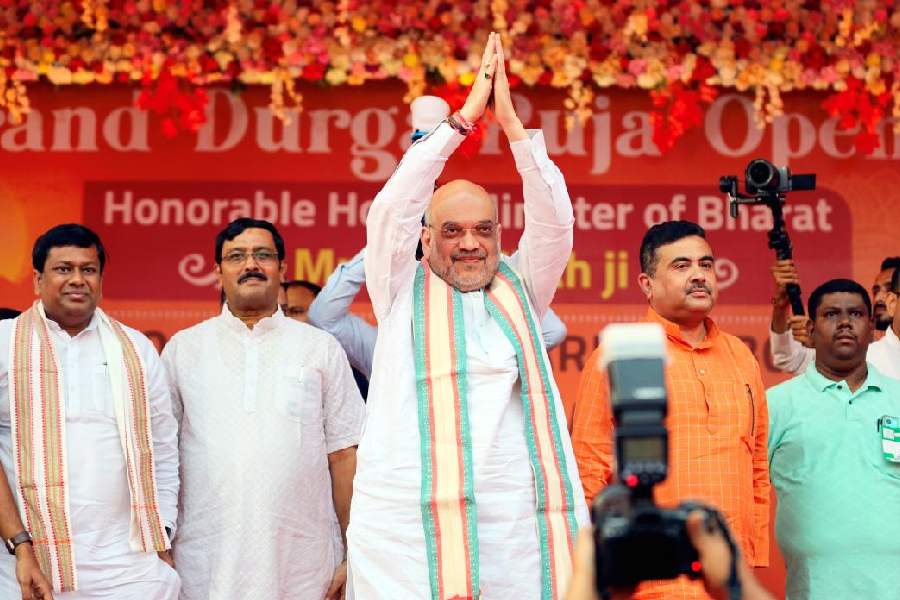The BJP’s expectations about its prospects in Bengal in the 2024 Lok Sabha polls have got a boost with what the party termed “an overwhelming response” to a Puja pandal, which was a replica of Ayodhya’s Ram Mandir and patronised by BJP councillor Sajal Ghosh, at Santosh Mitra Square in Calcutta.
Union home minister Amit Shah inaugurated the Puja pandal in central Calcutta on October 16, about three months before the formal unveiling of the temple in Ayodhya.
“This Puja has proven beyond doubt that Lord Ram has awakened in the hearts of Bengali Hindus.... We have all the reasons to be hopeful about its impact on the upcoming polls,” said Shishir K. Bajoria, a senior BJP leader.
Shah has set a target of 35 seats for the BJP in Bengal in the next general election. The target was unrealistic, even BJP insiders had admitted in private conversations in the past few months, in view of the party’s poor organisational strength in Bengal.
Both on-record and off-the-record conversations with state BJP leaders revealed that the replica of the Ram temple in central Calcutta and “an overwhelming response” to it seemed to have changed the mood in a section of the party.
“This year, we saw an overwhelming response to Santosh Mitra Square.... This is something we had not expected because we were not sure how people of the state would react to the Ram temple. The fact remains that Bengal is not like north Indian states,” a senior state BJP leader said on the condition of anonymity.
While explaining the concept of what he called the “awakening of Ram”, Bajoria said lakhs of pandal hoppers — who had turned up at the installation with devotion — were spontaneously chanting “Jai Shri Ram” even while waiting patiently in long queues.
“Theme of a pandal is very important in Bengal.... It depicts people’s thought process or something that is important for Bengal. The country is going to get Ram Mandir in a few months and the idea is resonating with a huge population of the country.... This time, it was proven that Ram resides in the hearts of the people of Bengal,” said Bajoria, before adding that Shah’s presence gave the idea a big push among the people of Bengal.
The stress on “this time” by the BJP leadership revealed that the party’s previous reach-out experiments during Durga Puja — which began with a Puja hosted by the party in 2020 and inaugurated virtually by Prime Minister Narendra Modi — had very little impact.
“That puja was organised in EZCC... Who will associate that venue with Durga Puja?” asked a source in the BJP.
“It was a botched-up idea of Mukul Roy (a Trinamul turncoat whose party affiliation is now under the scanner).... It was supported by Kailash Vijayvargiya, the then central minder, who had very little idea about Bengal,” added the source.
Not just Santosh Mitra Square turnout or Shah’s presence at its inauguration, the BJP leadership in Bengal is claiming “success” with this autumn’s reach-out initiatives. The season witnessed the visits of BJP president J.P. Nadda and Union
education minister Dharmendra Pradhan. Party insiders claimed that they managed
to challenge the Trinamul
hegemony in some puja committees — albeit small ones — in Calcutta and in some districts.
This perceived autumn success of the BJP, a political observer said, can be linked to the systematic efforts by central leaders — from Nadda to Shah and Smriti Irani to Pradhan — to make their presence felt in the state through regular visits during which they harped on the need for a change in Bengal.
The change chant, however, is not new in the BJP’s armoury as Modi and Shah, who steered the party’s poll campaign in 2021, did their best to wrest control of the state in the last Assembly polls.
Amid predictions in the BJP ranks on how close the party can inch to the 35 target, questions can be raised on whether the turnout of lakhs of people at a puja pandal — a common feature in Calcutta — or Shah’s presence at its inauguration are indicators of any surge in support base.
A Calcutta Police officer, who was on duty at Santosh Mitra Square, said the crowd at the Puja was “pretty decent” and was among the top few pandals in the city. “I found a significant presence of Hindi-speaking people among them.... I was barking out instructions in Hindi,” said the officer, before adding that he saw several vehicles bearing number plates of neighbouring states like Bihar and Jharkhand.
The cop’s observation is interesting in the backdrop of the BJP’s support base in Bengal, which has a disproportionate presence of non-Bengalis. Analysis of past election results — during which the BJP bagged the highest percentage of 40.7 per cent in 2019, followed by 37.97 per cent in 2021 — had revealed that the party did very well in areas with a high concentration of Hindi-speaking people.
In the past, several BJP insiders had said in private that the biggest challenge of the party was to get Bengali votes. “One jam-packed Santosh Mitra Square pandal and rounds and rounds of Jai Shree Ram chants cannot be held as indicators in a state like Bengal that has such a high minority concentration of voters. Don’t forget that the BJP’s other challenge is its declining support base in north Bengal,” said the political observer.
“The Puja drew a crowd because of its location. It is situated near Sealdah railway station, and thousands of people, who reach the city on local trains, visited it. Even on normal working days, the area looks crowded as thousands who return by train take the route where the pandal was constructed. The BJP leaders can claim anything about the rush to the pandal, but they know that will not help them gain any political dividends,” said Kunal Ghosh, a Trinamul state general secretary and the party’s spokesperson.










